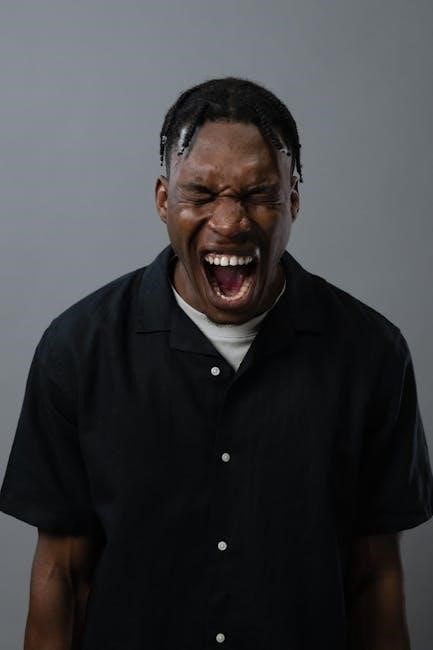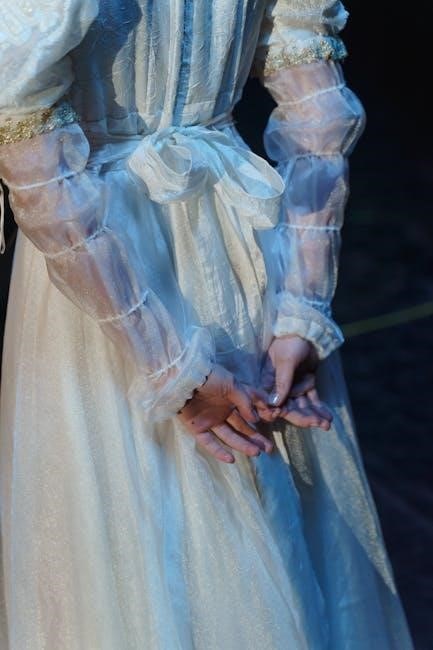
acting pdf
Acting techniques are essential for bringing characters to life, combining emotional depth, physical expression, and vocal control. They guide actors in portraying authentic performances, adapting to diverse roles and scripts effectively.
1.1 Overview of Major Acting Methods
Acting methods are structured approaches that help actors develop believable performances. The Stanislavski System, Meisner Technique, and Chekhov Technique are among the most renowned. Each method offers unique tools for actors to connect with characters emotionally and physically. Stanislavski emphasizes truthful emotional experiences, while Meisner focuses on spontaneity and living truthfully in the moment. Chekhov Technique uses psychological gestures to connect actors with their characters. Practical Aesthetics and Viewpoints approaches also provide frameworks for analysis and physical expression. These methods, while diverse, share a common goal: to empower actors to deliver authentic, compelling performances. By exploring these techniques, actors can expand their creative range and adapt to various roles and scripts. Understanding these methods is foundational for any actor seeking to master their craft.
1;2 Importance of Voice Techniques in Acting
Voice techniques are vital for actors, as they enable effective communication of emotions, thoughts, and character depth. Proper vocal control enhances clarity, projection, and resonance, ensuring the audience can engage fully with performances. Breath control and articulation are key components, allowing actors to adapt to various roles and stage or screen environments. Voice techniques also aid in creating authenticity, helping actors embody characters convincingly. By mastering these skills, performers can convey nuanced emotions and maintain consistency in their portrayals. Additionally, voice work supports physical acting, as it aligns with body language and expression. Overall, voice techniques are indispensable for delivering compelling and believable performances, making them a cornerstone of an actor’s training and practice.

Major Acting Methods

Major acting methods like Stanislavski, Meisner, and Chekhov provide frameworks for actors to immerse into roles deeply, ensuring authentic performances. These techniques, developed by pioneers, form the foundation of modern acting, evolving over time.

2.1 The Stanislavski System
The Stanislavski System, developed by Konstantin Stanislavski, is a foundational acting method that emphasizes emotional authenticity and psychological depth. It encourages actors to explore their characters’ motivations, desires, and emotional experiences through detailed script analysis and personal connection. Central to this approach are concepts like “emotional recall,” where actors draw from their own experiences to authentically portray emotions, and “given circumstances,” which involve immersing oneself in the character’s specific situation. The system also stresses the importance of physicality and vocal work to fully embody the character. By focusing on truth and believability, the Stanislavski System has become a cornerstone of modern acting techniques, influencing many subsequent methodologies and remaining widely practiced in theaters and drama schools worldwide.

2.2 The Meisner Technique

The Meisner Technique, developed by Sanford Meisner, emphasizes living truthfully in the moment. It focuses on the actor’s ability to respond spontaneously and authentically to stimuli, rather than pre-planning actions. This method encourages actors to listen and react instinctively, fostering genuine emotional responses. A key aspect is the “living truthfully” mantra, where actors immerse themselves in the scene’s reality, allowing their actions to emerge naturally. The technique also stresses the importance of ensemble work, with actors supporting each other to create cohesive performances. Practical exercises, such as word repetition and emotional recall, help actors connect with their emotions and the emotions of their scene partners. By prioritizing spontaneity and authenticity, the Meisner Technique empowers actors to deliver compelling, truthful performances that resonate deeply with audiences.
2.3 The Chekhov Technique
The Chekhov Technique emphasizes the use of imagination and psychological gestures to connect actors with their characters. Developed by Michael Chekhov, it focuses on transforming the actor’s energy and exploring the character’s psychological and emotional depth. This method encourages actors to visualize and embody the character’s essence through physical and vocal exercises. By imagining the character’s inner life and external movements, actors can create authentic performances. The technique also explores the concept of “radiating and receiving” emotions, allowing actors to interact truthfully with their environment and fellow performers. Practical exercises include working with imagery, sensory experiences, and the manipulation of physical centers of energy. This approach empowers actors to transcend personal limitations and fully inhabit their roles, making it a powerful tool for both beginners and seasoned performers.

Voice Techniques for Actors
Voice techniques enhance an actor’s performance by improving clarity, tone, and emotional expression. Methods like Practical Aesthetics and Viewpoints focus on aligning voice with physical movement for authentic storytelling.

3.1 Practical Aesthetics and Vocal Expression
Practical Aesthetics emphasizes the importance of action, event, and storytelling in acting. This approach, rooted in the work of David Mamet and William H. Macy, focuses on the actor’s physicality and voice as tools for expression. Vocal expression is integral, as it conveys emotion and intention, connecting the actor to the script and audience. Techniques include script analysis, sensory exercises, and improvisation to explore the character’s needs and actions. By integrating vocal techniques with physical movement, actors achieve authenticity and depth in their performances. Practical Aesthetics is widely taught in drama schools and workshops, offering a structured method for actors to refine their craft.
- Focuses on action and storytelling.
- Emphasizes physical and vocal expression.
- Encourages script analysis and improvisation.
- Helps actors connect with the audience through authenticity.
3.2 Viewpoints and Breath Control
Viewpoints, developed by Anne Bogart and Tina Landau, emphasize ensemble work and physical storytelling. This technique focuses on spatial relationships, tempo, and kinesthetic awareness, fostering a deeper connection between actors and the performance space.
Breath control is vital for actors, enhancing vocal projection, emotional expression, and stamina. Proper breathing techniques help manage performance stress, ensuring consistent delivery and authentic portrayal of emotions. Together, these elements refine an actor’s physical and vocal precision, creating a compelling stage presence.
Practical Exercises for Actors
Practical exercises enhance acting skills, helping actors connect emotionally and physically with roles. They include essential drills for beginners and advanced techniques, fostering authenticity and versatility in performances.
4.1 Essential Acting Exercises for Beginners
Beginners can benefit from foundational exercises that enhance emotional expression, physicality, and vocal clarity. Sense memory exercises help actors connect with sensory details, fostering authenticity. Emotional recall encourages accessing personal experiences to portray genuine emotions. Improvisation builds spontaneity and adaptability, crucial for scene work. Mirror exercises improve physical awareness and reaction skills, while vocal warm-ups strengthen articulation and projection. These exercises lay the groundwork for mastering more complex techniques, ensuring a solid foundation for growth as a performer.

4.2 Advanced Techniques for Seasoned Performers

Advanced acting techniques for seasoned performers focus on refining emotional depth, physical precision, and vocal mastery. These methods, such as emotional recall and physical transformation, enable actors to access complex emotions and embody characters fully. Script analysis and deconstruction are emphasized to uncover layered meanings and motivations. Seasoned actors often explore improvisation to spontaneity and authenticity in performances. Techniques like sense memory and affective memory are refined to connect deeply with a character’s experiences. Physical theater practices, such as mime and movement work, enhance versatility. Vocal techniques, including resonance and articulation, are polished for clarity and impact. Advanced exercises, such as viewpoints and actioning, help actors decode scripts and deliver nuanced performances. These techniques empower actors to transcend their roles, creating compelling and unforgettable portrayals on stage and screen.